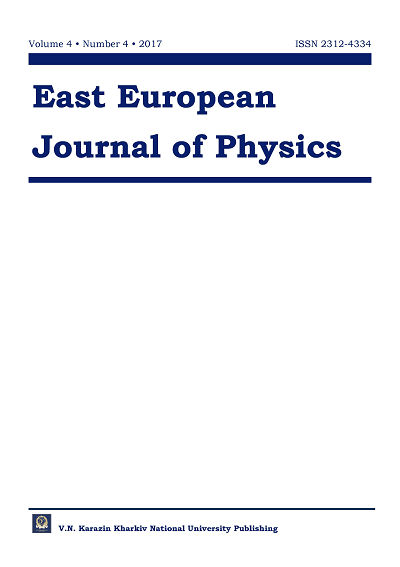INJECTION EFFICIENCY IN COMPTON RING NESTOR
Abstract
NESTOR is the hard X-ray source that is under commissioning at NSC KIPT. NESTOR based on the Compton scattering of laser photons on relativistic electrons. The structure of the facility can be represented as the following components: a linear accelerator, a transport channel, a storage ring, and a laser-optical system. Electrons are stored in the storage ring for energy of 40-200 MeV. Inevitable alignment errors of magnetic elements are strongly effect on the beam dynamics in the storage ring. These errors lead to a shift of the equilibrium orbit relative to the ideal one. Significant shift of the equilibrium orbit could lead to loss of the beam on physical apertures. Transverse sizes of electron and laser beams are only few tens of microns at the interaction point. The shift of electron beam at the interaction point could greatly complicate the operation adjustment of storage ring without sufficient beam position diagnostic system. This article presents the simulation results of the efficiency of electron beam accumulation in the NESTOR storage ring. Also, this article is devoted to electron beam dynamics due to alignment errors of magnetic element in the ring.
Downloads
References
2. Landecker K. Possibility of frequency multiplication and wave amplification by means of some relativistic effects // Physical Review. – 1952. – Vol. 86. – No.6. –– P. 852-855.
3. Artumanyan F., Tumanyan V. Compton effect on relativistic electrons and the possibility of generation of hard radiation // JETP. – 1963. – Vol. 44. – P. 2101.
4. Milburn R. // Thomson Scattering of Optical Radiation from an Electron Beam // Physical Review Letters. – 1963. – Vol. 10. – P. 75.
5. Gladkikh P., Karnaukhov I. et. al. Physical Grounding Н-100М // Internal report of NSC KIPT. – 1998. – P. 7-30.
6. Telnov V. Principles of photon colliders // Nuclear Instruments and Methods in Physics Research A. – 1995. – Vol. 355. – P. 3‑18.
7. Zelinsky A., Shcherbakov A. et al. The Kharkov X-ray generator facility NESTOR // Proceedings of IPAC. – 2013. – P. 2253‑2255.
8. Gladkikh P., Karnaukhov I. et al. The start of X-ray generator NESTOR commissioning // VANT. –2013. – Vol. 6(88). – P. 20‑23.
9. Zelinsky A., Kalamaiko A. et al. The First Results of the NESTOR Commissioning NESTOR // Proceedings of IPAC. – 2013. – P. 225–227.
10. Iselin F.C. The MAD Program. Physical Methods Manual // CERN/SL. –1992
11. Gladkikh P., Strelkov M., Zelinsky A. The Application Package DECA for Calculating Cyclic Accelerators // Proceedings of PAC-93. – 1993. – P. 194–196.
12. Drebot I., Karnaukhov I., ea at. Survey and alignment strategy for compton x-ray generator NESTOR // Proceedings of IPAC-2010. – 2010. – P. 4053–4055.
13. Zelinsky A., Kalamaiko A. et al. Simulation of the beam dynamics due to alignment error of magnetic elements in the Nestor ring // Proceedings of XIV conference on high energy physics, nuclear physics and accelerators. – 2016. – P. 62.
14. Dinev D. Closed orbit correction in synchrotrons // Physics of elementary particles and nuclear physics. – 1997. - Vol. 4(28). – P. 1013–1060.
Authors who publish with this journal agree to the following terms:
- Authors retain copyright and grant the journal right of first publication with the work simultaneously licensed under a Creative Commons Attribution License that allows others to share the work with an acknowledgment of the work's authorship and initial publication in this journal.
- Authors are able to enter into separate, additional contractual arrangements for the non-exclusive distribution of the journal's published version of the work (e.g., post it to an institutional repository or publish it in a book), with an acknowledgment of its initial publication in this journal.
- Authors are permitted and encouraged to post their work online (e.g., in institutional repositories or on their website) prior to and during the submission process, as it can lead to productive exchanges, as well as earlier and greater citation of published work (See The Effect of Open Access).








